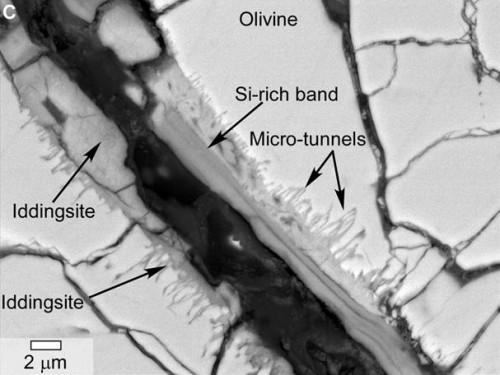
The debate over possible evidence for life on Mars is one of the most hotly debated subjects in space science, and some news released Feb. 27 is sure to add fuel to the fire. Studies of a Martian meteorite, known as Yamato 000593 (Y000593), have revealed signs of past liquid water activity as well as possible evidence of actual biological processes.
From the press release: “The team reports that newly discovered different structures and compositional features within the larger Yamato meteorite suggest biological processes might have been at work on Mars hundreds of millions of years ago.”
We’ve been down this road before. We all remember the uproar over the discovery of putative fossilized bacteria in the Allen Hills 84001 (ALH84001) Martian meteorite back in 1996. Those results are still considered inconclusive and dismissed by many scientists in the years since then. However, the research team, led by David McKay, Everett Gibson, and Kathie Thomas-Keprta, continues to stand by those findings. Those results were published in the journal Science.
The new discoveries, made by the same team, offer additional tantalizing clues to possible biological activity on Mars in the distant past. The water is interesting enough, but the fact that Mars used to have a lot of water on its surface is now considered old news. The other features found, however, are something else entirely.

Deep within the 3.7-kilogram (30-pound) meteorite, the researchers found tiny tunnels and micro-tunnels which look very much like similar tunnels formed in rocks by bacteria on Earth. The tunnels thread their way throughout the meteorite; their curving and undulating shapes are strikingly similar to bio-alteration textures observed in terrestrial basaltic glasses on Earth, which are created by the interactions of bacteria with basaltic materials.
As well as the tunnels, there are also nanometer-to-micrometer-sized spherules which are highly carbon-enriched, much more so than any of the surrounding layers of Iddingsite in the meteorite. Both of these features are similar to ones seen in another Martian meteorite, Nakhla, which fell in Egypt in 1911.
The meteorite was discovered on the Yamato Glacier in Antarctica in 2000 by the Japanese Antarctic Research Expedition.
“This is no smoking gun,” said the study’s lead author, Lauren White. “We can never eliminate the possibility of contamination in any meteorite. But these features are nonetheless interesting and show that further studies of these meteorites should continue.”
The published paper is available here.
This article was first published on The Meridiani Journal.




Thanks for that. A well written article.
Bob Clark
Whether this is evidence of microbial life or not, the analysis suggests that we are on the right track for the inevitable “great discovery” that will happen and forever change our understanding of the cosmos.